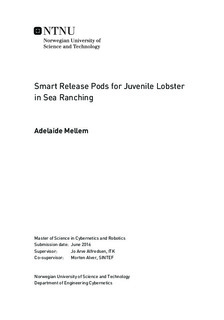| dc.description.abstract | Sea ranching of lobster is a sustainable alternative to mere fishing. The method involves releasing hatchery-reared juveniles into their natural environment, usually at a geographically delimited area. With this addition to the native populations one hopes to raise the overall numbers of specimens and increase the catching rates and financial gain.
Being small the juvenile lobsters are amongst the lower levels of the food chain. Predators are abundant all year round making the release process a dangerous affair. But the young lobsters size is not only a disadvantage when it comes to the food chain hierarchy; ocean dynamics such as currents may largely contribute to the dispersal, transporting the lobster miles away from the sea ranching site. These are amongst some challenges that if solved will increase the benefits of sea ranching. This thesis had the aim of addressing these problems and try to enhance the process focusing on release strategies.
A literature survey was conducted to gain knowledge on ecology and behaviour of the European lobster \textit{Homarus gammarus} and to get familiar with the practise of sea ranching
by reviewing previous experiences and improvement suggestions. Based on previous research several biological models of juvenile lobster behaviour were made. These were incorporated with the fine-scale hydrodynamic model SINMOD to look at spatio-temporal spreading patterns. The simulated releases were conducted at a specific site with environmental data from the period of May 1.- May 14. 2012. Simulation data were analyzed in terms of biological model used, time of day and flow fields. Results reveled that the lobsters vertical placement in the water column (depth) is most influential in terms of the amount of current induced transport. Because of the scarce amount of conclusive information on lobster behaviour, no immediate conclusion could be drawn. Some suggestions however were made based on the knowledge gathered. Releasing of older stage IV juveniles, or stage V juveniles is encouraged as more lobsters will settle at the sea ranching site. Releases should be conducted at night due to predators impaired vision in darkness. | |

